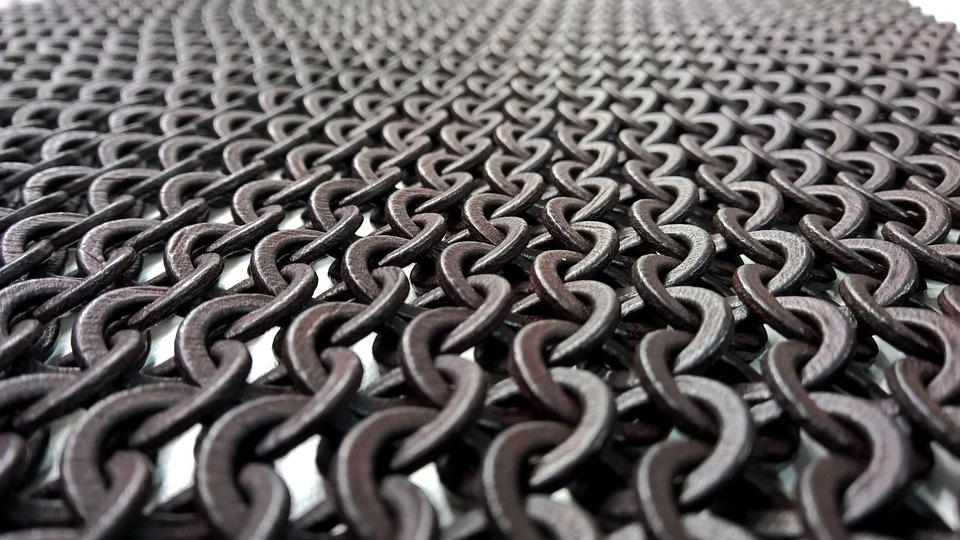Space is a dangerous environment, arguably the most dangerous when taking all of the hazards into account. There’s cosmic radiation, debris, asteroids, solar storms, and human error. In order to increase the level of protection that astronauts get while living under such perilous circumstances, NASA is continuously developing new safety technologies. Its newest offering is a 3D-printed chainmail, similar to what medieval knights used to wear in battle.
Of course, since it is chainmail, NASA developed it as a means of adding extra protection to spacecraft and spacesuits by basically lining them with the new fabric, The Space Reporter reports. Much like how chainmail is basically made up of interlocking rings, the new material is made up of interconnected tiles that are made of tough alloy. It’s a versatile, durable resource that can work with a variety of uses without its strength getting compromised.
The new material was actually created by Raul Polit Casillas, one of NASA’s systems engineers working in its Jet Propulsion Laboratory. What might have influenced the development of the fabric is Casillas’ background in the fashion industry since he is actually the son of a designer from Spain.
In terms of the idea behind the fabric, it’s pretty easy to understand why the space-age 3D-printed chainmail would make a lot of sense. The material is foldable and is easy to integrate into several pieces of machinery and delicate mechanical aspects of satellites, suits, and the International Space Station. As a result, it’s not too difficult to adopt both during preparations and emergency responses.
Casillas designed the fabric to have four main properties, Futurism reports, with considerable tensile strength working with its reflective characteristics, flexibility, and passive heat management. This covers many of the threats that astronauts and space ships often contend with in space. Best of all, thanks to advancements in 3D-printing technology, the material is incredibly cheap to produce.



 Trello Outage Disrupts Users as Access Issues Hit Atlassian’s Work Management Platform
Trello Outage Disrupts Users as Access Issues Hit Atlassian’s Work Management Platform  SpaceX Insider Share Sale Values Company Near $800 Billion Amid IPO Speculation
SpaceX Insider Share Sale Values Company Near $800 Billion Amid IPO Speculation  Microsoft Unveils Massive Global AI Investments, Prioritizing India’s Rapidly Growing Digital Market
Microsoft Unveils Massive Global AI Investments, Prioritizing India’s Rapidly Growing Digital Market  Australia Enforces World-First Social Media Age Limit as Global Regulation Looms
Australia Enforces World-First Social Media Age Limit as Global Regulation Looms  Apple App Store Injunction Largely Upheld as Appeals Court Rules on Epic Games Case
Apple App Store Injunction Largely Upheld as Appeals Court Rules on Epic Games Case  EssilorLuxottica Bets on AI-Powered Smart Glasses as Competition Intensifies
EssilorLuxottica Bets on AI-Powered Smart Glasses as Competition Intensifies  SoftBank Shares Slide as Oracle’s AI Spending Plans Fuel Market Jitters
SoftBank Shares Slide as Oracle’s AI Spending Plans Fuel Market Jitters  SK Hynix Shares Surge on Hopes for Upcoming ADR Issuance
SK Hynix Shares Surge on Hopes for Upcoming ADR Issuance  IBM Nears $11 Billion Deal to Acquire Confluent in Major AI and Data Push
IBM Nears $11 Billion Deal to Acquire Confluent in Major AI and Data Push  Adobe Strengthens AI Strategy Ahead of Q4 Earnings, Says Stifel
Adobe Strengthens AI Strategy Ahead of Q4 Earnings, Says Stifel  US Charges Two Men in Alleged Nvidia Chip Smuggling Scheme to China
US Charges Two Men in Alleged Nvidia Chip Smuggling Scheme to China  SpaceX Reportedly Preparing Record-Breaking IPO Targeting $1.5 Trillion Valuation
SpaceX Reportedly Preparing Record-Breaking IPO Targeting $1.5 Trillion Valuation  China Adds Domestic AI Chips to Government Procurement List as U.S. Considers Easing Nvidia Export Curbs
China Adds Domestic AI Chips to Government Procurement List as U.S. Considers Easing Nvidia Export Curbs  Taiwan Opposition Criticizes Plan to Block Chinese App Rednote Over Security Concerns
Taiwan Opposition Criticizes Plan to Block Chinese App Rednote Over Security Concerns  Moore Threads Stock Slides After Risk Warning Despite 600% Surge Since IPO
Moore Threads Stock Slides After Risk Warning Despite 600% Surge Since IPO  Trump Signs Executive Order to Establish National AI Regulation Standard
Trump Signs Executive Order to Establish National AI Regulation Standard  SK Hynix Considers U.S. ADR Listing to Boost Shareholder Value Amid Rising AI Chip Demand
SK Hynix Considers U.S. ADR Listing to Boost Shareholder Value Amid Rising AI Chip Demand 































